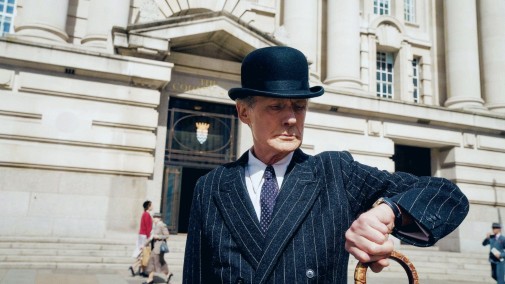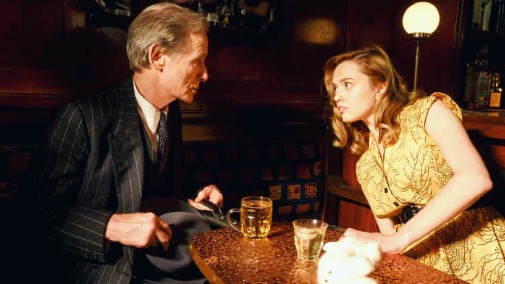
To remake a masterpiece is to invite comparison and risk redundancy. Still, filmmakers regularly throw themselves into the pit, asking for trouble. Oliver Hermanus is the latest maverick to tempt fate, joining the ranks of directors who have remade the work of Akira Kurosawa. This time around, the subject is one of the director's most beloved classics, Ikiru. It's the story of a stalwart bureaucrat who finds meaning in the last months of his life, discovering purpose in the shape of a playground when faced with the inevitability of death. The original flick is a sentimental jewel and a showcase for one of Kurosawa's favorite actors, Takashi Shimura. In 2022, the Japanese thespian shoes are filled by Bill Nighy, taking on a new version of the role that reimagines him as a British civil servant in 1952 London.
While I can't speak for worldwide critics and cinephiles, I confess myself happily surprised by Living. No matter how distasteful the prospect of a Kurosawa remake feels, these modern artists have devised a worthy reinterpretation…
Part of what makes Living work is how its makers come to the picture's subject as outsiders looking in. Kazuo Ishiguro has always existed in a liminal space between British and Japanese culture, exploring matters of repression through the prism of both societies. Some of his greatest works have excoriated the very idea of the stiff upper lip, illuminating the pains that come hand-in-hand with an unwillingness to be vulnerable, a repudiation of emotion. His script thus updates Kurosawa's text by approaching it in crucially different terms. For instance, gone are the narration and the sense of warning to a present-day audience. After all, this is no autopsy of contemporary malaise but a study on social mores of a time gone by. Specifically, England in the aftermath of war, when a sense of inertia had subsumed the country. The obsession with a return to normalcy had become national anesthesia.
Such period movie trappings also shape Hermanus' work. Reuniting with his Moffie cinematographer Jamie Ramsay, the South African director captures midcentury London in all its dreariness and paradoxical beauty. There's, at times, a balletic quality to the staging and cutting of routine, whether the movements of sharply dressed men at the train station or the spiral of staircases and delegation within a public office. The distance can become alienating, one must confess, and there's no denying how sleepy the movie's first act feels. However, that dormant turpitude is part of the point, a tool through which Living diagnoses social inhumanity. In other words, it's a feature rather than a fault, an accidental byproduct of prestige filmmaking.

The chilly beauty is disrupted by splotches of color and tempting reflections. For example, Sandy Powell's costumes indicate a world that hasn't entirely moved on from the war years, though young people in bright hues pop in the background at all times. Theirs is a chromatic yearning for hope and life that complements the journey of Bill Nighy's Mr. Williams. For, despite the impeccable design and formal polish, Living depends on its leading man to function. He's the catalyst of all historical musings and the beating heart through which the film can find its way out of Ikiru's shadow. Thankfully, for all involved, Nighy is nothing short of extraordinary. He delivers what might well be the performance of a lifetime, finding the specificity in his character's anguish as he peels back layers of accumulated niceties, pursuing the aching personhood beneath the good manners.
While one wants to avoid direct comparison, the different ways Shimura and Nighy perform a drunken song exemplify how each actor made the role their own. The original is a picture of stillness, his eyes frozen in a trance-like state. Looking at him is to be plunged into a well of overwhelming sorrow, his tears shining for all to see. Nighy is both more active and less demonstrative, playing a man who, even in profound inebriation, is still mostly able to keep it together. The song breaks him, though, but instead of letting us see it in tearful eyes, he closes himself to us and the other characters. He sings with eyes closed, an apparent effort not to cry until he can't continue the charade. Throughout Living, the English thespian negotiates similar scenes by varying levels of self-effacement and self-denial. He plays the heightened sentiment of an existential crisis by illustrating the force necessary to keep it at bay and under control. He projects the shyness and the inarticulated fear that hide everything.
Furthermore, just as Shimura was attuned to Kurosawa's cinematic rhythms, so is Nighy in service of Ishiguro and Hermanus's vision. By keeping faithful to Ikiru's structure while condensing it into a film that's 40 minutes shorter, the filmmakers have truncated scenes and added ellipsis where before was contemplation. This makes the flick feel rushed in parts but also urgent, disjointed even if it never quickens its step. Moreover, the pacing confers strange qualities to Nighy's characterization, deepening the fractures of a broken man searching for mending before the end. The music exacerbates this frustration, weeping plaintive strings, crying for change in a life that appears to have meant nothing. It's in these fractured turbulences that Nighy strives, anchoring it all with elegance, serving as mirror and counterpoint. His gentility defines Living illuminates the oft-overlooked miracle of human connection. The actor finds and gives it purpose.
Did the world need a remake of Ikiru? Certainly not. However, I'm happy to have Living, especially Bill Nighy's melancholic performance.